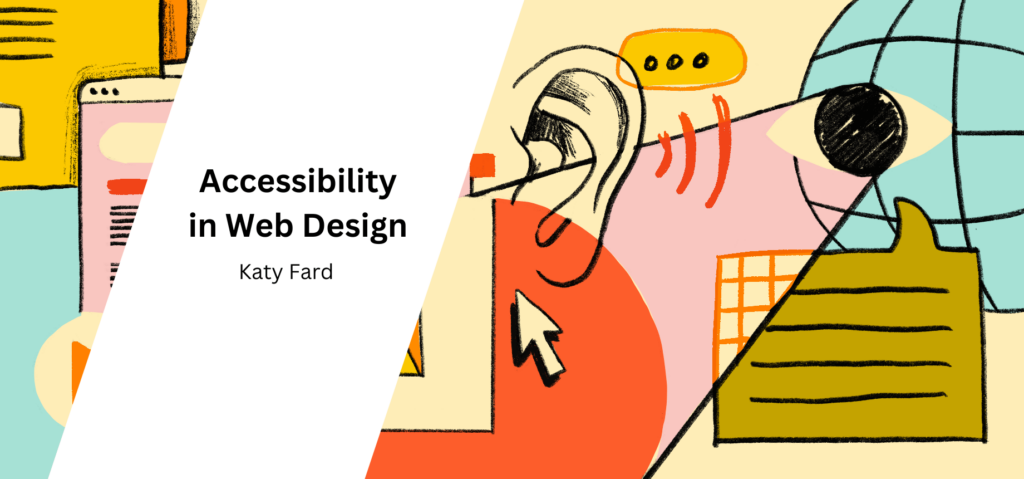In recent years, there has been a growing emphasis on creating digital experiences that prioritize accessibility in web design, making it accessible to everyone. This has led to the development and implementation of principles and best practices for inclusive web design. These principles are not just about accommodating people with disabilities, but they also benefit a wide range of users, including older individuals, people with temporary limitations, and those using a variety of devices and environments for accessing the web.
The core principles of accessibility in web design are outlined in the Web Content Accessibility Guidelines (WCAG), published by the World Wide Web Consortium (W3C). These principles, often abbreviated as “POUR,” stand for Perceivable, Operable, Understandable, and Robust. Let’s delve into these principles a bit further to understand how they are shaping modern web design trends.
-
Perceivable: The first important element in accessibility in web design
The perceivable principle is focused on ensuring that all web content is presented in a way that can be perceived by all users, including those with visual, auditory, or other perceptual disabilities. To achieve this, web designers need to consider factors such as providing text alternatives for non-text content, ensuring that content can be presented in different ways without losing meaning, and using distinguishable colors and contrasts.
This is the part where we hear a lot about Alt site images and we don’t know the reason! One of the most important uses of Alt images is accessibility in web design.
Modern web design trends influenced by this principle include the use of descriptive alternative text for images, ensuring that videos have captions or transcripts, and considering the use of different sensory modalities such as sound and touch to convey information. Designers are also exploring innovative ways to present content to make it perceivable to a broader audience, which includes experimenting with voice interfaces and haptic feedback for users with visual impairments.
-
Operable:
The operable principle is focused on ensuring that user interface components and navigation are operable by all users. This accessibility in web design includes providing keyboard accessibility, giving users enough time to read and use content, and avoiding content that can cause seizures. Modern web design trends influenced by this principle involve the use of clear and consistent navigation structures, providing focus indicators for keyboard users, and minimizing the use of content that might trigger adverse reactions, such as flashing animations.
Additionally, designers are increasingly considering the needs of users with motor impairments, who may rely on alternative input methods. This has led to the design and development of web interfaces that are navigable and actionable using assistive devices such as switches, sip-and-puff devices, and eye-tracking technology. By incorporating these considerations, modern web design is becoming more accessible and user-friendly for individuals with diverse needs.
-
Understandable:
The understandable principle emphasizes the need for content to be presented in a way that is easy to understand for all users. This involves making text readable and understandable, ensuring that content appears and operates in predictable ways, and providing clear instructions and error prevention. Modern web design trends influenced by this principle include the use of plain language, clear typography, and consistent design patterns that help users understand and interact with content more effectively.
Furthermore, designers are focusing on reducing cognitive load by simplifying complex interactions and providing clear feedback. This benefits not only users with cognitive disabilities but also people accessing the web in distracting or high-stress environments. By prioritizing understandable design, modern web experiences are becoming more intuitive and accessible to a broader audience.
-
Robust:
The robust principle emphasizes the importance of creating content that is compatible with current and future user tools, including assistive technologies. This involves using technologies that are compatible with assistive technologies and ensuring that content remains accessible as technologies evolve. Modern web design trends influenced by this principle include the use of semantic HTML, adherence to web standards, and the adoption of progressive enhancement and graceful degradation strategies.
Designers are also exploring ways to ensure that web content is future-proof and can adapt to new assistive technologies and user preferences. This includes considering the interoperability of web content with emerging technologies such as virtual reality, augmented reality, and wearable devices. By embracing robust design principles, modern web experiences are positioned to evolve and remain accessible as new technologies continue to emerge.
In addition to the core principles outlined above, modern inclusive web design is also shaped by the following trends and best practices:
1- Mobile Responsiveness:
With the widespread use of mobile devices for accessing the web, responsive design has become a standard practice. This trend benefits users with disabilities who may rely on mobile devices and tablets, as well as those who benefit from the flexibility of responsive interfaces.
2. Design Systems and Component Libraries:
The adoption of design systems and component libraries has led to more consistent and accessible user interfaces. By adhering to established design patterns and accessibility guidelines, designers can create accessible experiences more efficiently and effectively.
3. User Testing and Feedback Loops:
Modern web design processes often include extensive user testing and feedback loops, which help identify accessibility barriers and areas for improvement. This accessibility in web design, approach ensures that accessibility is a continuous consideration throughout the design and development lifecycle.
4. Inclusive User Research:
Designers are increasingly prioritizing inclusive user research to understand the diverse needs and preferences of all users. By gaining insights from a wide range of individuals, designers can create more inclusive and impactful digital experiences.
5. Accessibility Automation Tools:
The availability of accessibility evaluation and testing tools has facilitated the identification of accessibility issues in web content. Designers are integrating these tools into their workflows to identify and address accessibility issues early in the design process.
6. Legal and Ethical Considerations:
The legal and ethical landscape around web accessibility has also influenced modern web design trends. Organizations are increasingly recognizing the importance of providing equal access to digital services, leading to greater investment in accessible design practices.
In summary, the principles of inclusive web design are shaping modern web design trends by emphasizing the importance of creating digital experiences that are accessible to all users. Through the application of principles such as perceivable, operable, understandable, and robust design, along with other best practices and trends, designers are creating more inclusive and user-friendly web experiences. By prioritizing accessibility, web design is evolving to meet the diverse needs of an increasingly broad audience, resulting in a more positive and impactful user experience for everyone.
If you have any specific questions or would like to explore any aspect of accessibility in web design in more detail, feel free to ask!


You mentioned the feedback loop in this article. Accessibility in web design. What do you mean?
Hello Sonia;
A feedback loop is a process in which the output of a system is returned to its input, potentially influencing subsequent outputs. This loop allows a system to self-regulate or self-correct by using information from previous outputs to adjust future behavior. In a positive feedback loop, the output reinforces the input, leading to amplification or exponential growth. In contrast, a negative feedback loop dampens the output, promoting stability and equilibrium. Feedback loops are fundamental in various fields, including biology, engineering, and economics, where they play a crucial role in maintaining balance, stability, and adaptation within complex systems.
How can designers ensure that their user research includes a diverse range of individuals with varying needs and preferences?
Designers can ensure that their user research includes a diverse range of individuals with varying needs and preferences by prioritizing accessibility in web design. Firstly, they should actively recruit participants from diverse backgrounds, ensuring that their research methods are inclusive and accessible to all. Secondly, cultural sensitivity and collaboration with community partners can help designers understand and address the specific needs of different groups. By incorporating accessibility in web design, such as offering multiple feedback channels and being open to diverse perspectives, designers can create a more inclusive research environment. This approach not only fosters diversity in user research but also promotes the development of more accessible and user-friendly web experiences.
Hey Katy Fard
What are some common challenges designers face when conducting inclusive user research, and how can these challenges be addressed?
Hello Millar;
Designers often encounter difficulties in conducting inclusive user research, such as ensuring diverse participation, accommodating different needs, and understanding various communication styles. To address these challenges, designers can actively reach out to underrepresented groups, provide multiple ways for people to participate, and seek guidance from cultural experts. They should also use inclusive language and be mindful of power dynamics during research. Seeking feedback from a wide range of people can help identify and address any blind spots. Ultimately, these efforts contribute to improving accessibility in web design, ensuring that websites are usable by everyone, regardless of their background or abilities.
How have accessibility evaluation and testing tools improved the identification and resolution of accessibility issues in web content?
Accessibility evaluation and testing tools have significantly improved the identification and resolution of accessibility issues in web content by automating the detection of common accessibility issues such as missing alternative text for images, improper use of headings, and low color contrast. By focusing on accessibility in web design, these tools provide developers with real-time feedback and suggestions for improvement, making it easier to identify and fix accessibility issues during the development process. This has led to greater awareness of web accessibility best practices and has ultimately resulted in more inclusive and accessible web content for all users.